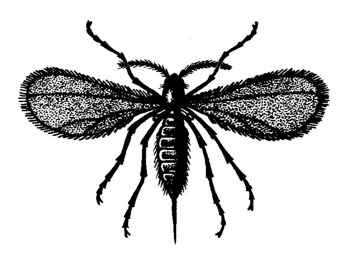Pests
Stenodiplosis panici Plotnikov - Millet Fly, Millet Small Mosquito
Systematic position.
Class Insecta, order Diptera, family Cecidomyiidae, genus Stenodiplosis Reuter.Biological group.
Pest of millet.Morphology and biology.
Body reddish; mesonotum and upper side of abdomen brownish. Head small; eyes large and black. Antennae have 13 segments in female, 11 in male. Palpi 3-segmented. Legs long and thin; tibia as long as femur; tarsus 5-segmented with sparse hairs. Wing venation reduced, including only 3 longitudinal veins. Ovipositor is as long as abdomen. Body length is 1.5-2 mm. Adults do not feed after emergence. Female lays eggs after pairing on spicate scale of millet, generally before beginning of flowering. Egg ovate with costulate surface, primarily yellowish, later brownish. Fertility reaches 160 eggs. Larvae migrate after hatching inside the flower, feeding on sap of stamens, pistil, and ovary. No more than 4 larvae can develop in one millet flower. The larva of last instar is flattened and fusiform, orange in color. Most mature larvae pupate in flowers; some migrate to soil for pupation. Pupa free and flexible with wing pads and rudiments of antennae and legs; abdomen orange-red. Pupa project half from flower scales before emergence of adult. At air temperatures of 18-25°C and a humidity of 60-70%, development of eggs lasts 2-3 days, that of larva 7-8 days, and that of pupa 3-4 days. Adult longevity is 3-6 days. Long diapause during larval stage is possible after drought and abrupt fluctuations of temperature. Larvae hibernate among after-harvest residues, inside fallen grains, and in the seeds of Echinochloa crusgalli. Hibernation ceases in spring with the increase of humidity and air temperatures of about 18-25°C.Distribution.
The species is distributed throughout West Palaearctic regions. The species inhabits the southern European region of the former USSR (most parts of Ukraine, the Central Chernozem Region of Russia, Ciscaucasia, and the Lower and Middle Volga Region), the Caucasus, Central Asia, Kazakhstan, and adjacent territories of Siberia north (approximately) to the border between July isotherms of 19-20╓C.Ecology.
The species develops on Panicum miliaceum and Echinochloa crusgalli. It produces 3-5 generations in the southern part of its distribution area; individuals of the 1st, 4th and 5th generations develop on Echinochloa crusgalli. Millet Fly abundance increases with high temperatures and rains in the spring. Drought is unfavorable for adults. Adults of the 1st generation fly in June and lay eggs on weeds; those of the 2nd generation fly in the beginning of July, populating crops of early and mid-season millet. The flies of the 3rd generation fly in August, populating crops of late millet. Adults of the 4th generation fly in the beginning of September and develop on Echinochloa crusgalli. Systasis encyrtoides Wlk., Inostemma panici Sel., Eupelmus alboannellatus Bel. are parasites of Millet Fly larvae.Economic significance.
The pest causes damage during the larval stage. Injured ears of millet are distinguished by their whitish color. Harmfulness of Millet Flies has decreased in recent decades. Control measures include sowing millet at an early time for short periods, autumn plowing, recycling of wastes after thrashing of grain, and control of Echinochloa crusgalli.Related references:
Belyaev, I.M. 1974. Pests of grain plants. Moscow: Kolos. 284 p. (in Russian).Fedotova, Z.A. 1999. To fauna of gall midges (Diptera, Cecidomyiidae) in Middle Volga Region. In: Saksonov, S.V., ed. Bulletin "Samarskaya Luka" (9/10): 51-82. (in Russian).
Fedotova, Z.A. 2000. Phytophagous gall midges (Diptera, Cecidomyiidae) in deserts and mountains of Kazakhstan: morphology, distribution, phylogeny and taxonomy. Samara: Samarskaya GSKhA. 803 p. (in Russian).
Mamaev, B.M. 1969. Family Cecidomyiidae. In: Bei-Bienko, G.Ya., ed. Keys to the insects of the European part of the USSR. V. 5 (1). Leningrad: Nauka. P. 356-420 (in Russian).
Mamaeva, Kh.P. & Mamaev, B.M. 1981. Family Cecidomyiidae. In: Narchuk, E.P. & Tryapitsyn, V.A., eds. Insects and mites - pests of agricultural plants. V. 4. Hymenoptera and Diptera. Leningrad: Nauka, 68-99 (in Russian).
Narchuk, E.P. 1980. Family Cecidomyiidae. In: Kopaneva L.M., ed. Key to the harmful and useful insects and mites on grain plants in the USSR. Leningrad: Kolos, p. 261-265. (in Russian).
Pavlov, I.F. 1983. Field crops protection against pests. Moscow: Rossel'khoizdat. 224 p. (in Russian).
Pyl'nov, I.V. 1956. To biology of Stenodiplosis panici Rohd. in Kuibyshev Region. In: Florov, D.N., ed. Proc. of Kuybyshev Ped. Institute. Biology and chemistry (16). Kuybyshev: Kuybyshev Ped. Institute, p. 121-140 (in Russian).
Shchegolev, V.N., ed. 1955. Agricultural Entomology. Leningrad & Moscow: Sel.khozgiz. 616 p. (in Russian).
Vasil'ev, V.P., ed. 1974. Pests of agricultural crops and forest plantations. V. 4. Kiev: Urozhai. 606 p. (in Russian).


